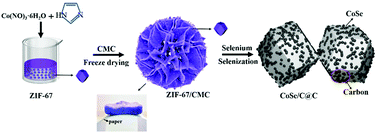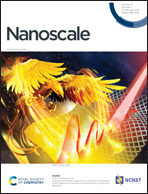Synthesis and characterization of metal–organic framework/biomass-derived CoSe/C@C hierarchical structures with excellent sodium storage performance†
Abstract
Metal selenide has attracted much attention for use in rechargeable batteries due to its excellent conductivity and considerable capacity. However, it is still necessary to achieve a long cycle life and excellent Na+ storage performance to enable its practical application. Volume expansion and poor stability of selenide during operation also hinder its industrial applications. As metal–organic frameworks and aerogels possess porous structures, carbon materials derived from them can effectively reduce the volume expansion of selenide, resulting in improving cycling stability and enhancing Na+ storage. In this work, CoSe/C@C composites with a hierarchical structure were successfully prepared by freeze-drying and in situ selenization as anode materials. The CoSe/C@C composites exhibited superior cycling stability (a capacity of 332.3 mA h g−1) and capacity retention (63.1% compared to the second cycle) at 200 mA g−1, after 500 cycles. CoSe/C@C also exhibited a high rate performance of 403.4 mA h g−1 at 2 A g−1. Moreover, thanks to the high capacitance contribution and some redox reactions during cycling, the CoSe/C@C electrode possesses outstanding rate capability.



 Please wait while we load your content...
Please wait while we load your content...